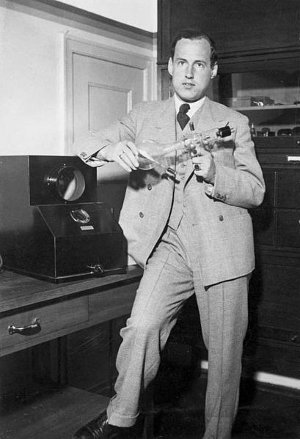A Biography of Manfred von Ardenne, the Inventor of Scanning Electron Microscope

The German physicist and inventor, Manfred von Ardenne is probably best known for his involvement in the atomic bomb project in the Soviet Union. However, he also played an important role in electron microscopy and went into history as the inventor of scanning electron microscope. After Ernst Ruska who developed the first electron microscope, Manfred von Ardenne is one of the most important figures in the field of electron microscopy although his invention became fit for practical use only when his instrument was further developed by the British physicist and electronic engineer Sir Charles Oatley in the mid-1960s.
Manfred von Ardenne was born in 1907 in Hamburg to a wealthy family. Already as a child, von Ardenne was interested in everything involving technology and enjoyed support of his parents. In 1919, he continued his education at the Realgymnasium in Berlin, while his interest in technology and physics developed into a serious scientific research. In 1923 – at the age of 15 years, he obtained his first patent for an electric tube for wireless telegraphy. In the same year, he left school to help Siegmund Loewe with radio engineering. Using the very same electronic tube with multiple system that was patented by von Ardenne in 1923, Loewe built an inexpensive radio receiver (Loewe OE333). With the income from patent sale and publications, von Ardenne made considerable improvements in the broadband amplifier which in turn was crucial for television and radar development.
At the age of 21, von Ardenne got a full control of his inheritance. He of course used to set up his own research laboratory in Berlin where he continued his research in the field of radio and television technology. However, he also became interested in electron microscopy and built the world’s first scanning electron microscope in 1937. At the end of the Second World War, he made a pact with Gustav Hertz, Peter Adolf Thiessen and Max Volmer. According to this pact, whoever from the four scientists would made contact with the Soviets would speak for all four. Thus all four scientists were taken to the Soviet Union after the end of the war.
Von Ardenne stayed in the Soviet Union until 1954 and helped the Soviets in their atomic bomb project. Meanwhile, however, he also worked in electron microscopy and developed a table-top electron microscope. After he returned to (East) Germany, he became a professor at the Dresden University of Technology but he also founded a research institute “Forshungsinstitute Manfred von Ardenne” and pursued his research in a number of fields. At the time of his death in 1997, he held about 600 patents in the fields of electron microscopy, radio and television technology, nuclear technology, plasma physics and medical technology, and received a number of awards for his work. The most notable ones include the (double) Stalin Prize, (double) National Prize of East Germany and the Order of Lenin.